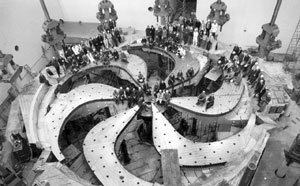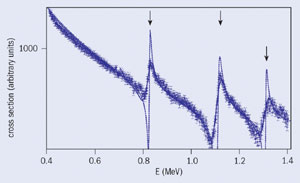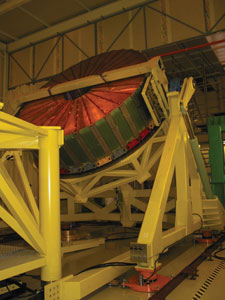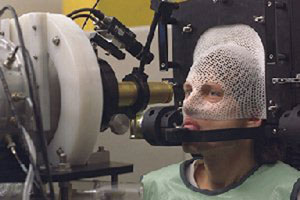TRIUMF supports a broad range of research at the world’s largest cyclotron, as well as coordinating Canadian contributions to international particle physics.

The acronym for Canada’s national laboratory for particle and nuclear physics, TRIUMF, was out of date almost as soon as it was coined. Derived from “TRI-University Meson Facility”, it reflected the three universities – British Columbia, Victoria and Simon Fraser – that initially conceived the Vancouver laboratory in 1965. Well before the proposal was approved in 1968, however, the University of Alberta had come on board, and today 11 Canadian universities belong to the TRIUMF club. The remainder of the acronym has also become rather misleading, since TRIUMF is now more than a meson facility. The laboratory’s current activities include operating the radioactive beam facility, ISAC, and the coordination of Canada’s role in the Large Hadron Collider (LHC) project at CERN.
The TRIUMF cyclotron was built under the guidance of J Reginald Richardson, who studied under Ernest Lawrence at Berkeley. It produced its first beam in 1974. The cyclotron is literally at the heart of the laboratory, with a meson hall to one side and a proton hall to the other. It was the first cyclotron in the world to provide two extracted beams simultaneously at different energies. Today, it provides four beams supplying experiments in particle and nuclear physics, astrophysics, materials science, and a range of medical and industrial applications.
Particle and nuclear physics
In recent years, TRIUMF’s on-site particle physics experiments have been centred around two major facilities, TWIST and CHAOS. TWIST (the TRIUMF Weak Interaction Symmetry Test detector) was built by a 30-strong Canadian-Russian-US collaboration. It uses a stack of precision tracking chambers within a superconducting solenoid to measure the energy spectrum and angular distribution of the decay positrons from highly polarized muons, with the aim of determining the so-called Michel parameters to a few parts in 10-4. The purely leptonic decay m → e n n- is one of the best experimental tools for studying the structure of the weak interaction, providing an opportunity to explore physics beyond the V-A structure of the Standard Model. The current data-taking phase should provide intermediate results for the p and d parameters at the 10-3 level by the end of 2003.
CHAOS (the Canadian High Acceptance Orbit Spectrometer) has been used by a Canadian-Italian-German-Australian-US collaboration to test the predictions of Chiral Perturbation Theory (ChPT) by determining its low energy constants from a study of pion-nucleon scattering at low energies. One programme has focused on differential cross section and analysing power measurements over a large angular range at energies below the D resonance. These measurements have led to much more precise phase shifts and a determination of the S term related to the strangeness content of the nucleon. It has confirmed a revision of the pion’s strong coupling constant gppp towards lower values (13.05 ± 0.008).
A second programme has studied observables in pion-induced pion production on the proton to access the pion-pion scattering lengths a0pp and a2pp, which are calculable in ChPT. This programme has also been conducted on a range of nuclei to study a possible renormalization of the pion field in nuclei.
Radioactive beams

In 1995, the Canadian federal government and the province of British Columbia approved funding for a state-of-the-art radioactive beam facility at TRIUMF – the Isotope Separator and Accelerator (ISAC; CERN Courier July/August 2001). ISAC is supplied by a 40 mA, 500 MeV proton beam from the cyclotron, which interacts with a target to produce isotopes with lifetimes as short as 10 ms for study. These are either fed directly to experiments in a low-energy area, or accelerated in RFQ and drift-tube linacs to 1.5 MeV/u for use in a high-energy area.
The low-energy beams (up to 60 keV) are used in a broad programme covering fundamental symmetry tests, nuclear structure studies in nuclei far from stability, and condensed matter studies using light polarized ions. Precision measurements of pure-Fermi b-decay lifetimes and branching ratios have been made for 74Rb, and together with that of the Q value, when complete, will improve the testing of CVC and the determination of the Vud element of the quark-mixing matrix. Correlation studies in b decay with trapped atoms (the TRINAT programme with 38mK and polarized 37K) are placing constraints on extensions of the Standard Model.
A low-temperature nuclear orientation refrigerator for online NMR and perturbed angular correlation studies, and a large germanium gamma-ray detector array (the former Chalk River 8p spectrometer), are being used in studies of nuclear structure.
A novel facility for b-NMR studies of condensed (especially superconducting) materials has been commissioned. Light polarized ions (currently 8Li) are produced via collinear polarized laser beam excitation, while the spectrometer sits at an adjustable high voltage. The range of the ions can be adjusted so that they stop on the surface of the sample or at a prescribed depth, allowing studies of magnetism on surfaces, in thin layered materials and at interfaces.
On 25 July 2001, the first accelerated beam was delivered to the high-energy area. Early experiments included studies of unstable isotopes that are important in the rapid proton and neutron capture processes of nova and supernova nucleosynthesis. ISAC’s nuclear astrophysics programme is carried out at two complementary facilities in the high-energy area – a large-acceptance recoil spectrometer system (DRAGON) and a large-acceptance scattering facility (TUDA).
Early measurements made with DRAGON include a study of the capture of a proton by sodium-21 to yield magnesium-22, a key step on the way to the production of sodium-22 in novae. One of TUDA’s first measurements was the elastic scattering of a sodium-21 beam from a proton target, which yielded information that helps to constrain the sodium-21/magnesium-22 reaction at the high temperatures found in novae. Future measurements will explore other key processes in the nucleosynthesis cycles of novae, as well as reaction chains that are important in normally burning stars.
Work on an upgrade to the ISAC facility, ISAC-II, began in spring 2002 and is scheduled for completion by 2005. ISAC-II will incorporate a superconducting linac to extend the facility’s reach, providing 6 MeV/nucleon ions up to atomic masses of around 150, and 15 MeV/nucleon light ions.
Muon spin rotation
The condensed matter programme is very active, with 150 users served by three muon beamlines. By stopping highly polarized muons in a sample and studying the relaxation of their spins using muon spin rotation (mSR) techniques, forefront research is carried out in superconductivity, exotic superconductors, magnetism, semiconductor impurity behaviour, and (in chemistry) free radicals, supercritical water, and gas-phase reaction rates.
Particle physics off-site

TRIUMF provides infrastructure support for Canadian physicists involved in experiments at other laboratories, with the help of staff stationed both at TRIUMF and at the member universities. Its major current activity is coordinating Canada’s contribution to CERN’s LHC proton-proton collider and the ATLAS experiment. The first phase of the LHC work (from 1995 to 2000) provided magnets, power supplies, HV equipment, kickers, RF cavities, diagnostics and electronics towards upgrading the PS Booster and PS machines to meet LHC beam requirements. Beam dynamics work included design of the LHC cleaning insertions. The second phase, providing components for the LHC itself, will bring the total contribution to C$41 million (€28 million): 52 warm twin quadrupoles for the cleaning insertions (CERN Courier December 2002); the injection kicker power supplies; and beam-position-monitor electronics.

The Canadian ATLAS group (and hence TRIUMF) is involved in several construction projects centred around measuring particle energies in the liquid argon Hadronic Endcap Calorimeters (HECs): half of the main 4 m diameter HECs, now delivered to CERN (with the University of Alberta); the forward HECs (with Carleton and Toronto); and the 50 feedthrough ports, each with 1920 signal lines, for the endcap cryostats (with Victoria). TRIUMF is also involved in building the pipeline electronics for the calorimeters and the third-level trigger electronics (with Alberta), in developing physics simulations (for which it is an active member of the GEANT4 consortium), and in participating in the ATLAS data challenge and high-speed data-transfer test between TRIUMF and CERN in preparation for ATLAS data analysis (Canadians set record for long-distance data transfer).
The laboratory is also strongly involved in the HERMES experiment at DESY, Germany, and in the rare decay searches E787 (where the first-ever K+ →p+ n n- events have now been seen) and K0PI0 (K0 → p0 n n-) at the Brookhaven Alternating Gradient Synchrotron. Significant contributions have also been made to BaBar at SLAC, US, and continue at the Sudbury Neutrino Observatory (SNO) in eastern Canada.
Advanced detectors
The University of British Columbia and TRIUMF are constructing an integrated infrastructure facility at TRIUMF to develop innovative detector technology for scientific, medical and industrial applications. The Laboratory for Advanced Detector Development (LADD) is funded by the Canada Foundation for Innovation and the British Columbia Knowledge Development Fund, in conjunction with the University of Montreal and the British Columbia Cancer Institute. These facilities are pooling resources and personnel to form a world-class R&D partnership unique in Canada. LADD’s state-of-the-art infrastructure will enable Canadian universities to provide important contributions to experiments in high-energy and nuclear physics, materials and astrophysical sciences, and medical imaging applications.
LADD research will concentrate on the development of new types of imaging detectors and systems for gamma rays and charged particles – key components in fundamental physics experiments and in industrial and medical imaging applications. Initial projects include detector systems for the K0PI0 experiment at Brookhaven and positron emission tomography (PET) imaging technologies.

The application of basic physics has always been high on TRIUMF’s agenda, with pioneering work on muon-catalysed fusion and medical applications being carried out at the laboratory. Although the initial promise offered by the muonic atom approach to fusion has not been realized, TRIUMF’s medical work has led to important spin-offs. In the 1970s and 1980s, the laboratory investigated the use of pions in cancer therapy. The motivation for this came from a 1961 paper by Peter Fowler and Donald Perkins that pointed out that pions – like other hadrons – deposit most of their energy in a Bragg peak at the end of their trajectories. Moreover, when pions are captured, the capturing nucleus disintegrates, adding a star burst of radiation to the Bragg peak that could increase the effectiveness of the treatment. Clinical trials showed that while the side effects were less severe for patients who received pion therapy rather than more conventional treatment, the survival rate was the same, so the programme was ended. However, cancer treatment at TRIUMF continues, with a proton beam in routine use to treat eye tumours.
TRIUMF research into new radioisotopes for medical applications is exploited directly by the medical isotope firm MDS Nordion, under an agreement whereby TRIUMF receives royalties on sales. The company operates two small cyclotrons on site (one designed in a TRIUMF-Ebco collaboration), and is currently installing a third. The laboratory is also involved in projects with local hospitals, for example operating, and providing a source of radiotracers for, the PET scanners for the UBC Neurodegenerative Disorders Centre, which is renowned for its research into Parkinson’s disease.
Non-medical work includes a proton irradiation facility developed with space science applications in mind. The TRIUMF cyclotron’s energy range is well matched to that of protons from solar flares, making them ideal for evaluating materials to be used in space.
Future plans
Since 1995, TRIUMF has been funded on the basis of two 5 year plans – an arrangement that has enabled the lab to make commitments to sizeable projects such as ISAC-I, ISAC-II and the CERN LHC collaboration. But what of the future? The wheels of government grind slowly, and it will soon be time to submit a proposal for the years 2005-2010. For the past year, the TRIUMF user community and management have been engaged in a process to determine what should be included. This is not yet complete, but there seems to be broad agreement that the lab’s main thrust must be to exploit the newly completed ISAC facilities as fully as possible (perhaps providing additional simultaneous radioactive ion beams), while continuing to supply major engineering support for Canadian physicists’ experiments at other labs. Such a programme should provide exciting research possibilities for the future.







